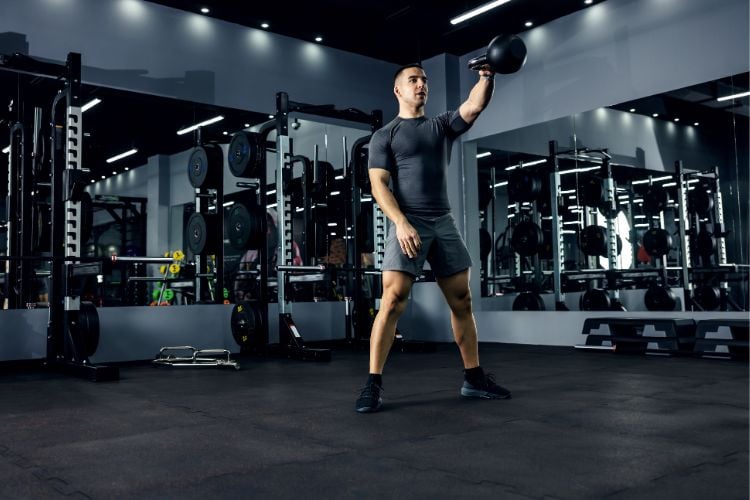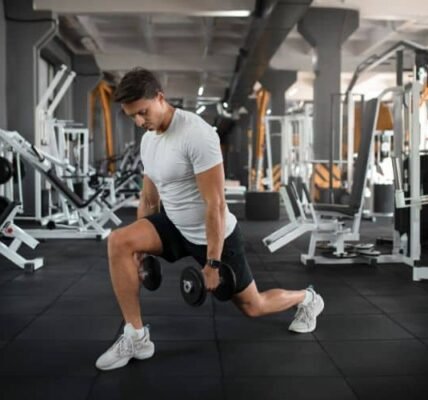
Looking to take your core training to the next level in just 30 minutes? A kettlebell is all you need. Kettlebell core workouts are dynamic, challenging, and incredibly effective for building strength, stability, and definition in your abs. Whether you’re a beginner or an advanced athlete, a 30-minute session can deliver powerful results — boosting posture, power, and total-body coordination.
In this guide, you’ll discover the benefits of kettlebell core training, the best exercises to include, and a complete 30-minute kettlebell core workout you can do anywhere.
30-Minute Kettlebell Core Workout to Sculpt Abs and Burn Fat
Functional Strength Meets Core Control
Unlike traditional core workouts that isolate the abs, kettlebell training targets the core in a functional way — engaging deep stabilizing muscles along with the more visible six-pack abs. Every kettlebell movement requires balance, coordination, and bracing through your core to control the weight.
Burn More Calories
A 30-minute kettlebell workout for core doesn’t just sculpt your midsection — it can also torch fat and increase your heart rate. Kettlebell movements combine resistance and cardio, which promotes fat loss and reveals leaner muscle definition over time.
Improve Athletic Performance
A strong core translates to better performance in almost every athletic activity, from lifting weights to running. Kettlebell core workouts build rotational strength, spinal stability, and explosive power — essential for sports, functional fitness, and everyday movement.
What Muscles Do Kettlebell Core Workouts Target?
Kettlebell exercises work the entire core musculature, including:
- Rectus abdominis – the “six-pack” muscle
- Obliques – responsible for rotation and lateral flexion
- Transverse abdominis – deep core stabilizer
- Erector spinae – supports the lower back
- Hip flexors and glutes – crucial for dynamic control
Because kettlebell movements are compound in nature, you also engage shoulders, lats, and legs — offering a true full-body workout with a core focus.
Equipment You Need
- 1 kettlebell (start with 10–20 lbs for beginners; go heavier if experienced)
- Mat for floor-based exercises
- Timer or app for intervals
No fancy machines or gym required — just space, sweat, and a kettlebell.
30-Minute Kettlebell Core Workout Overview
This kettlebell core circuit is structured in three main sections:
- Warm-Up (5 minutes)
- Core Circuit Training (20 minutes)
- Cool-Down & Stretching (5 minutes)
Workout Format
- Work time: 40 seconds
- Rest time: 20 seconds
- Complete 4 rounds total
- Do each of the 5 exercises per round
Warm-Up (5 Minutes) Kettlebell Core Workout
Before jumping into the core workout, it’s important to activate the entire body to prevent injury and enhance performance.
Dynamic Warm-Up
- Bodyweight Squats – 1 minute
- Torso Twists – 1 minute
- High Knees or Jog in Place – 1 minute
- Arm Circles + Shoulder Rolls – 1 minute
- Cat-Cow Stretch on All Fours – 1 minute
Now your body is primed for an intense 20-minute kettlebell core blast.
Core Circuit (20 Minutes) Kettlebell Core Workout
Perform the following five kettlebell core exercises in a circuit-style format. Do 4 rounds, resting 1 minute between rounds if needed.
1. Kettlebell Russian Twists
Muscles targeted: Obliques, rectus abdominis
How to do it:
- Sit on the floor, holding the kettlebell at chest level.
- Lean back slightly and lift your feet off the ground.
- Rotate your torso to the left, tapping the kettlebell beside your hip, then to the right.
- Keep your core tight throughout.
2. Kettlebell Plank Pull-Through
Muscles targeted: Transverse abdominis, shoulders, lats
How to do it:
- Get into a high plank position with a kettlebell placed outside your left hand.
- Reach your right hand under your body and pull the kettlebell across to your right side.
- Repeat with the other hand.
- Maintain a flat back and avoid twisting your hips.
3. Kettlebell Windmill
Muscles targeted: Obliques, shoulders, hips
How to do it:
- Press a kettlebell overhead with one arm.
- Rotate your feet about 45 degrees away from the loaded arm.
- Slowly hinge at your hip, reaching your opposite hand toward the ground.
- Keep your eyes on the kettlebell and core engaged.
- Return to standing. Repeat on both sides.
4. Kettlebell Dead Bug Press Core Workout
Muscles targeted: Deep core stabilizers, shoulders
How to do it:
- Lie on your back with your knees bent at 90 degrees.
- Hold a kettlebell with both hands above your chest.
- Extend one leg toward the floor while pressing the kettlebell up.
- Return and repeat on the other side, alternating legs.
5. Kettlebell Standing Halo
Muscles targeted: Shoulders, obliques, core
How to do it:
- Hold a light kettlebell by the horns.
- Circle it around your head slowly and under control.
- Keep your hips still and core braced.
- Reverse the direction halfway through the interval.
Cool-Down & Stretching (5 Minutes)
Finish your session by relaxing and restoring mobility.
Core-Focused Cool-Down
- Child’s Pose with Reach – 1 minute
- Cobra Stretch – 1 minute
- Seated Forward Fold – 1 minute
- Spinal Twists (Seated or Lying) – 1 minute
- Breathing in Supine Position – 1 minute
This cooldown helps release tight muscles and reset your nervous system.
Tips for Maximizing Your Kettlebell Core Training
Focus on Form First
Using momentum or improper technique reduces the effectiveness of each exercise and increases your injury risk. Start light and perfect your form before increasing weight or speed.
Engage Your Core Consciously
Simply moving a kettlebell isn’t enough. You must actively brace your core as if preparing for a punch to the stomach. This turns every movement into a full abdominal contraction.
Choose the Right Kettlebell Weight
For core-specific movements, go lighter than your usual swing weight. Aim for moderate resistance that challenges your stability without compromising form.
Stay Consistent
Try to include this 30-minute kettlebell core workout 2–3 times per week, alternating with other strength or cardio routines for a well-rounded fitness plan.
Benefits of a 30-Minute Kettlebell Core Workout
1. Improved Posture and Spinal Health
Your core acts as a stabilizer for your entire body. Strengthening it helps reduce back pain and promotes better posture throughout the day.
2. Enhanced Performance in Other Exercises
A strong core translates to heavier lifts, faster sprints, and greater balance in yoga, Pilates, or functional training.
3. Time-Efficient and Versatile
30 minutes is all it takes to feel the burn and see results. You can do this workout at home, in the gym, or even at the park — all you need is one kettlebell.
4. Boosted Fat Burning
Combining core strength with cardio-like kettlebell movements increases calorie burn. You get the muscle-building benefits of strength training with the fat-blasting benefits of HIIT.
Modifications and Progressions
For Beginners
- Perform fewer rounds (2–3)
- Extend rest periods to 30–40 seconds
- Use a lighter kettlebell or bodyweight only for select movements
For Advanced Athletes
- Add a weighted vest
- Reduce rest to 15 seconds or less
- Add reps to each movement or extend intervals to 45–60 seconds
Sample Weekly Schedule Including Kettlebell Core Workouts
| Day | Workout Focus |
|---|---|
| Monday | 30-Minute Kettlebell Core |
| Tuesday | Lower Body Strength (Bodyweight or Weights) |
| Wednesday | Active Recovery (Yoga/Walk) |
| Thursday | Kettlebell Full-Body Conditioning |
| Friday | 30-Minute Kettlebell Core |
| Saturday | HIIT or Cardio Intervals |
| Sunday | Rest or Mobility Work |
Build a Stronger Core in Just 30 Minutes
Kettlebell core workouts are more than just ab training — they’re a full-spectrum approach to strength, power, and performance. With this 30-minute routine, you’ll feel the challenge, sweat through every round, and build a more capable core over time.
Whether your goal is to burn belly fat, sculpt your midsection, or enhance functional fitness, this kettlebell core workout delivers results — fast, efficient, and accessible.
FAQs: 30-Minute Kettlebell Core Workouts
Is 30 minutes enough for a good core workout?
Yes! If structured properly with compound movements and time-efficient circuits, 30 minutes is more than enough to challenge and strengthen your entire core.
Can kettlebell exercises burn belly fat?
While no exercise burns fat from one spot, kettlebell workouts burn calories and build muscle, which helps reduce overall body fat, including belly fat.
What weight kettlebell should I use for core training?
Start with 10–20 pounds depending on your experience level. Use a weight that allows proper form but still feels challenging by the last 10 seconds of each exercise.
Ready to Transform Your Core?
Grab your kettlebell, hit start on the timer, and commit to just 30 minutes. You’ll feel the difference — and see it, too.




